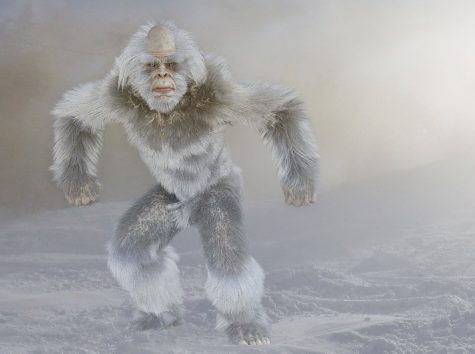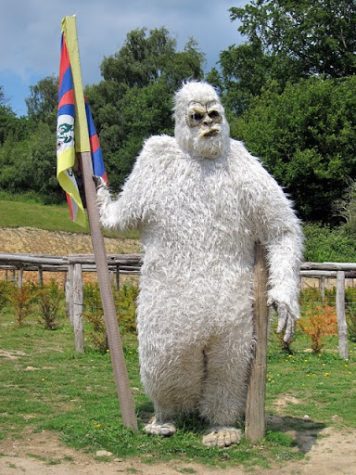Mysteries, Oddities, and Everything Strange: Yeti
January 8, 2022
Yeti: The Bigfoot of the North
Unfortunately, the holiday season has just come to a close. If you happen to celebrate Christmas, one of the biggest holidays in the world, you likely will have seen the 1964 classic, Rudolph the Red-Nosed Reindeer. If you recall the plot of this 51-minute holiday classic, you will remember the presence of a certain giant snow creature plaguing the main characters known as the Abominable Snowman. Sure, the one in the special might be a complete and utter work of fiction with no basis in reality, but the legend that it surfaced from is one of the most popular urban legends to date. The Abominable Snowman is most commonly known as the Yeti, and tales of it wandering the peaks of the Himalayan Mountains in Asia are a renowned part of local folklore. But what is the Yeti exactly? Is it just a misplaced Bigfoot? Or is it something more than that, an unknown creature who has haunted travelers and mountain-climbers for generations?
 So what exactly does this mountain dweller look like? Well, according to most sightings, the Yeti appears as a bipedal ape creature with white hair and large teeth. Occasionally it possesses varying colors of fur, like red, brown and gray, but it mostly commonly sports the color of an albino animal. It is extremely muscular and weighs between 200 and 400 pounds, standing at 1.8 meters tall or just about 6 feet. Despite this, Yetis are said to have come in a variety of heights and sizes, like most variations in organisms. The name is derived from the Tibetan words for “rocky” and “bear”. Siberian sightings described a Neanderthal-like creature that tended to be very reclusive.
So what exactly does this mountain dweller look like? Well, according to most sightings, the Yeti appears as a bipedal ape creature with white hair and large teeth. Occasionally it possesses varying colors of fur, like red, brown and gray, but it mostly commonly sports the color of an albino animal. It is extremely muscular and weighs between 200 and 400 pounds, standing at 1.8 meters tall or just about 6 feet. Despite this, Yetis are said to have come in a variety of heights and sizes, like most variations in organisms. The name is derived from the Tibetan words for “rocky” and “bear”. Siberian sightings described a Neanderthal-like creature that tended to be very reclusive.
The name “The Abominable Snowman” also has its own origins. It was introduced in the early 1920’s by a British Lieutenant-Colonel named Charles Howard-Bury, who discovered enormous footprints in an expedition to Mount Everest. His tour guide informed him of the local legend known as the “The Wild Man of the Snows”, web through misconstrued translations he identified the creature as some sort of snowman-like bear. Henry Newman, a newspaper writer and journalist, interviewed the crew, and from there he coined the name. The title is now an important part of its culture and has spread throughout modern cryptid culture.
Sightings of the monster occurred even before the 19th century, influencing local religious beliefs like Buddhism. Nearby cultures worshiped the “wild man” that was frequently depicted in art as carrying a large stone weapon. The first modern sighting came in 1832, when a James Prinsep encountered a trail of footsteps he concluded to belong to orangutans. In 1942, two hikers witnessed two creatures moving a good distance below them and went on to give a very detailed description of the creatures to Myra Shackley, a researcher that used their account in her novel Still Living? Yeti, Sasquatch, and the Neanderthal Enigma. One of the most credible sightings comes from Anthony Wooldridge, who photographed a strange creature 500 feet away from him that had created a trail of footprints. The fever surrounding these photographs was a craze, as Yeti believers everywhere jumped at the scene—until closer analysis proved them to simply be rock outcroppings.
Buddhism. Nearby cultures worshiped the “wild man” that was frequently depicted in art as carrying a large stone weapon. The first modern sighting came in 1832, when a James Prinsep encountered a trail of footsteps he concluded to belong to orangutans. In 1942, two hikers witnessed two creatures moving a good distance below them and went on to give a very detailed description of the creatures to Myra Shackley, a researcher that used their account in her novel Still Living? Yeti, Sasquatch, and the Neanderthal Enigma. One of the most credible sightings comes from Anthony Wooldridge, who photographed a strange creature 500 feet away from him that had created a trail of footprints. The fever surrounding these photographs was a craze, as Yeti believers everywhere jumped at the scene—until closer analysis proved them to simply be rock outcroppings.
There is a severe dearth of evidence supporting the Yeti’s existence, with most credible sources being proven false through careful examination. Most DNA evidence came to be humans, bears, or even dogs. The most intriguing piece of evidence, despite this, comes from an over 40,000 year-old piece of hair. It shared traits of both a polar bear and a brown bear, which implied it originated from a sort of hybrid animal as the two species were separating. Even with this intriguing discovery, no Yeti evidence could even be backed up. Despite this, Yeti believers are fervent in their ideas, claiming the scarcity only proves their exclusivity as creatures.
 The world has still been awed by this creature for decades, even though it is mostly a thing of urban legend. Bhutan, a country located in the heart of the Himalayas, secured a national park for the protection of these elusive beasts. The Daily Mail, along with journalist Ralph Izzard, facilitated a manhunt in order to find the Yeti, but turned up empty-handed. A missing Yeti relic was accidentally smuggled out of the Pangboche Monastery, which had been transported to Great Britain by Gloria Stweart, wife of It’s A Wonderful Life star Jimmy Stewart. The Russians and even the Nazis rushed to find even a shred of evidence of the creature, but found little success. The Yeti has been rumored to exist on every continent except Antarctica, and from now until forever its legend will be told from generation to generation.
The world has still been awed by this creature for decades, even though it is mostly a thing of urban legend. Bhutan, a country located in the heart of the Himalayas, secured a national park for the protection of these elusive beasts. The Daily Mail, along with journalist Ralph Izzard, facilitated a manhunt in order to find the Yeti, but turned up empty-handed. A missing Yeti relic was accidentally smuggled out of the Pangboche Monastery, which had been transported to Great Britain by Gloria Stweart, wife of It’s A Wonderful Life star Jimmy Stewart. The Russians and even the Nazis rushed to find even a shred of evidence of the creature, but found little success. The Yeti has been rumored to exist on every continent except Antarctica, and from now until forever its legend will be told from generation to generation.
Resources:
https://en.m.wikipedia.org/wiki/Yeti
https://www.livescience.com/25072-yeti-abominable-snowman.html
https://www.grunge.com/214070/the-legend-of-the-yeti-explained/






















































